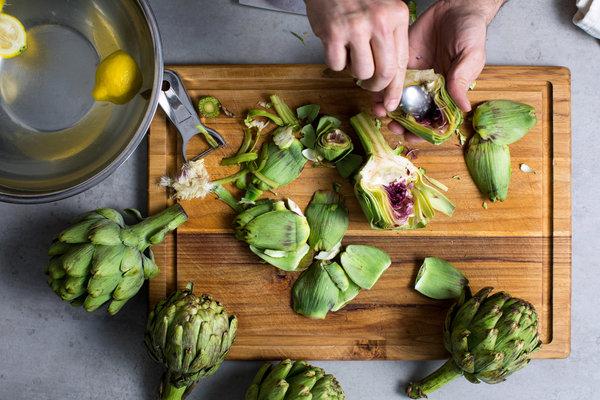An artichoke is not a vegetable. It is a flower, or it would be, if it were allowed to bloom. At the stage we eat it, before the bright purple blossom emerges, the artichoke is actually a fat, succulent bud.
There are many types, some the size of an egg and others as big as baseballs, in colors from pale green to violet.
You may see artichokes in the supermarket year-round, but they are at their peak from March to June, freshly harvested and full of flavor.
There is no denying, however, that an artichoke requires a bit of work. First, you discard a number of tough outer petals, or bracts. For large artichokes that are to be steamed whole, most cooks snip off the sharp tips of each petal with kitchen shears and cut off a portion of the top. Steaming takes about an hour.

These artichokes require a bit of preparation: First, discard a number of tough outer petals. Then, pull out the hairy, inedible choke at the center.CreditAndrew Scrivani for The New York Times
Then comes the familiar ritual of plucking off petal after petal and nibbling on the tiny bit of flesh each one offers, anticipating the sweet, meaty heart of the artichoke at the center, the prize of the whole ordeal. All the while, you are dipping into an accompanying sauce, whether melted butter, vinaigrette or mayonnaise.
There are other approaches: Roasting is one. An old-fashioned way is to cook smaller artichokes in the hot embers of a wood fire. This gives them, obviously, a smoky, roasted flavor that emphasizes their sweetness. If you have the opportunity, give it a try some time.
Another popular preparation is to stuff large artichokes with a savory bread crumb mixture and roast them whole.
But I have an easier method for roasting medium artichokes. I trim them, cut them in half and remove the hairy, inedible choke, then simmer them in salted water for 10 minutes. All this can be done well in advance of roasting.
A half-hour before serving, I drizzle them with olive oil, tuck a few thyme sprigs here and there and pop them into a hot oven. The artichokes emerge crisp, with a tender interior. I serve them with a zesty, lemony anchovy-flecked mayonnaise.
They may, of course, be served as a side dish, but I like them best as a first course, to be enjoyed without distraction.
Recipe: Roasted Artichokes With Anchovy Mayonnaise
Follow NYT Food on Twitter and NYT Cooking on Instagram, Facebook and Pinterest. Get regular updates from NYT Cooking, with recipe suggestions, cooking tips and shopping advice.






